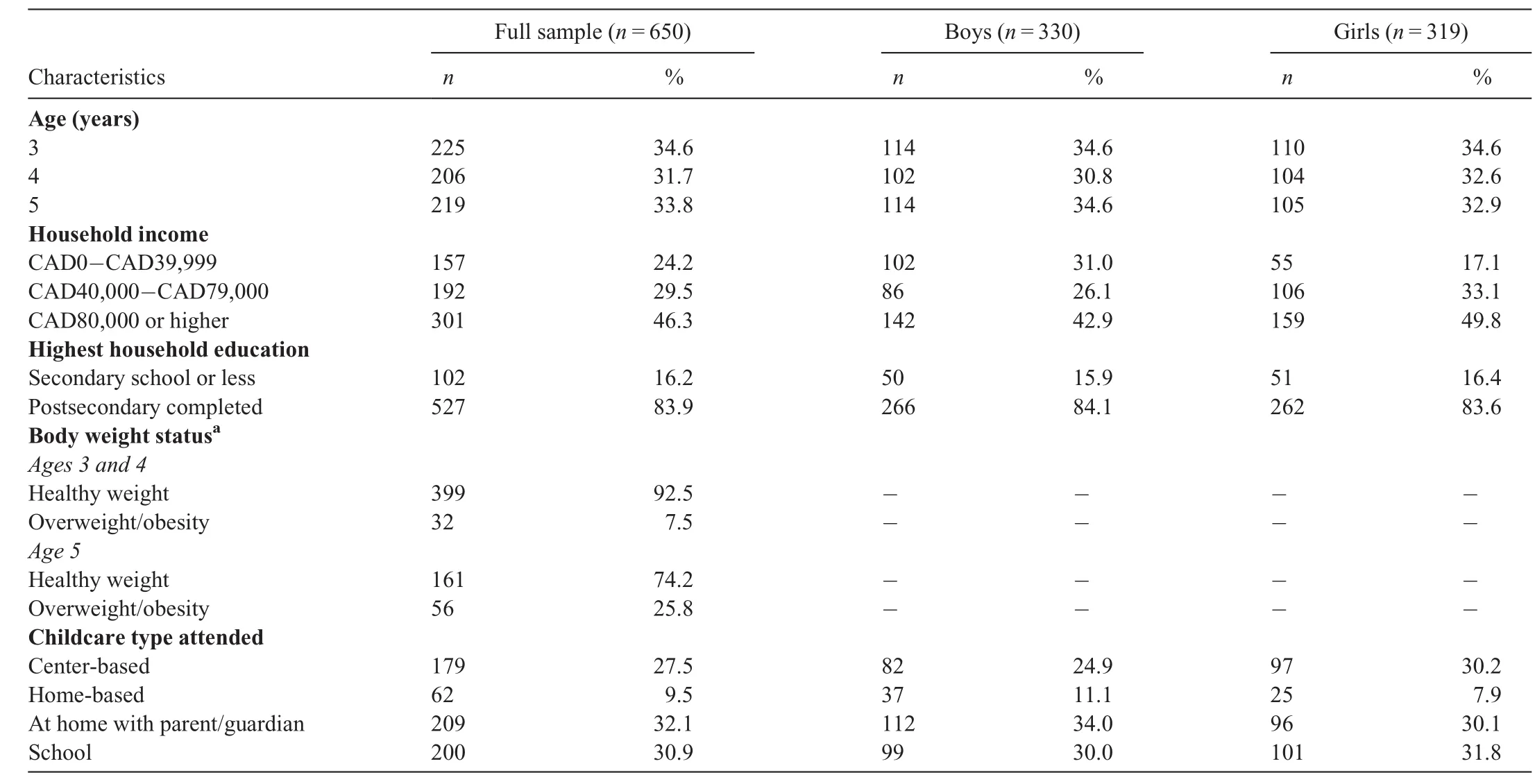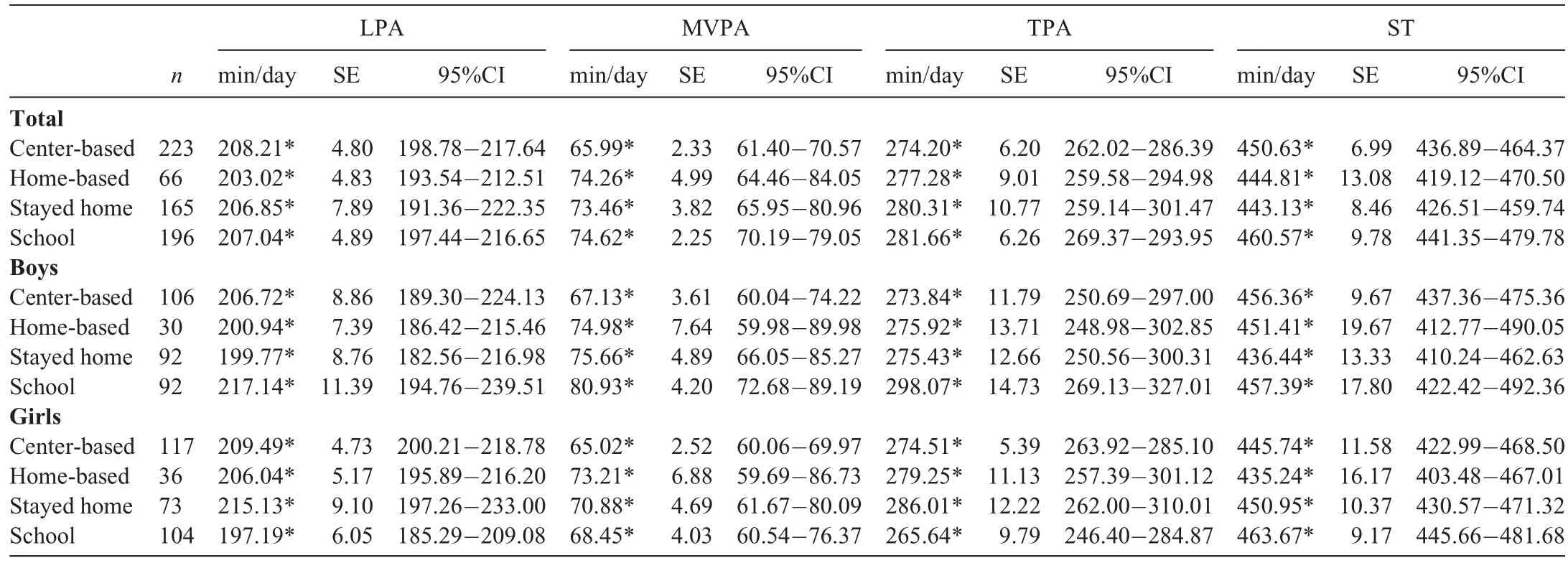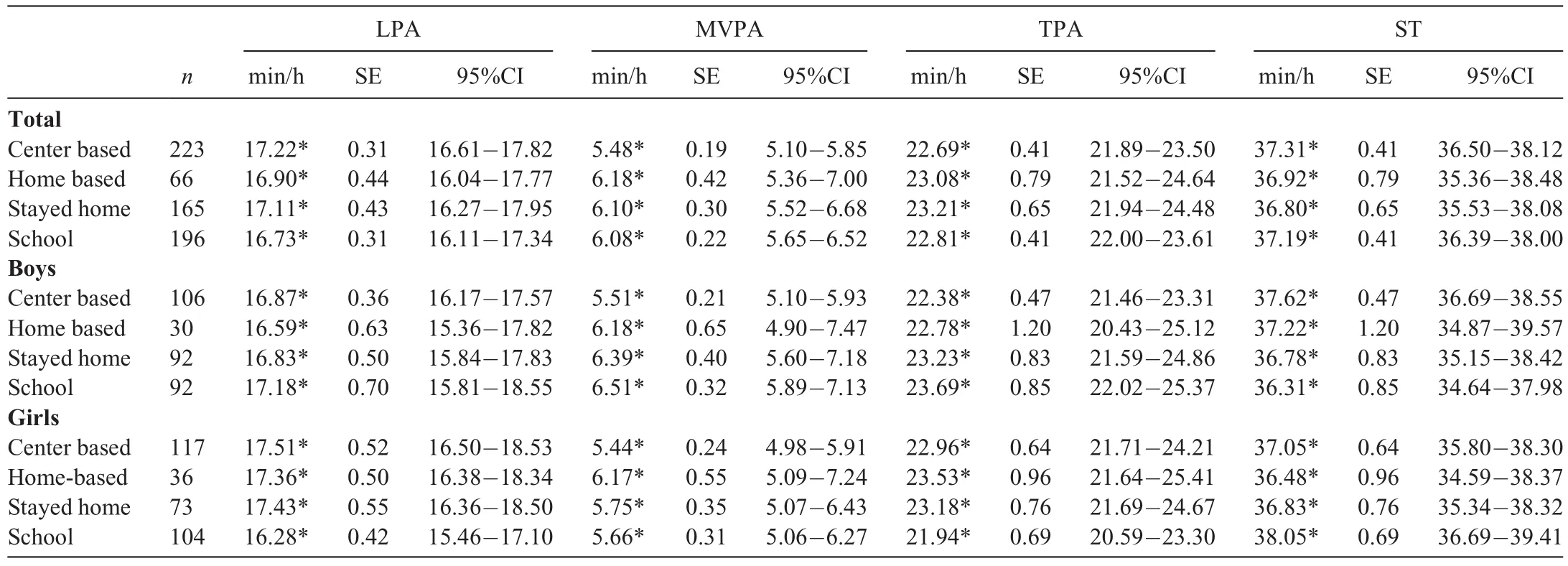Habitual physical activity levels and sedentary time of children in different childcare arrangements from a nationally representative sample of Canadian preschoolers
2020-12-18JulieSttlerPiotrWilkBrinTimmonsRhelColleyPtriiTuker
Julie Sttler,Piotr Wilk,Brin W.Timmons,Rhel Colley,Ptrii Tuker*
aFaculty of Health Sciences,University of Western Ontario,London,Ontario,N6A 3K7,Canada
bSchulich School of Medicine&Dentistry,University of Western Ontario,London,Ontario,N6A 3K7,Canada
cDepartment of Pediatrics,McMaster University,Hamilton,Ontario,L8S 4L8,Canada
dDivision of Health Analysis,Statistics Canada,Ottawa,Ontario,K1A 0T6,Canada eSchool of Occupational Therapy,University of Western Ontario,London,Ontario,N6A 3K7,Canada
Abstract Background:Children spend substantial time in childcare,and the reasons parents choose a particular childcare type may differ by family.However,little is known about how childcare type in fluences habitual(full day)activity levels among children.Therefore,exploring patterns between childcare type and habitual physical activity(PA)(i.e.,light,moderate-to-vigorous PA(MVPA),and total PA)and sedentary time(ST)in young Canadian children is needed.Methods:A nationally representative sample of preschoolers from Cycles 3 and 4 of the Canadian Health Measures Survey was used in this cross-sectional study.Childcare type(e.g.,center-based childcare,home-based childcare,home with parent,kindergarten)was reported by parents.Preschoolers wore an Actical accelerometer for 7 days.Device and population-spcific cut-points were applied to delineate PA intensities and ST.Population means and sample totals were calculated to examine average daily and hourly rates of activity.Results:Preschoolers'rates of MVPA and total PA from the 4 childcare arrangements ranged from 65.99 min/day to 74.62 min/day(5.48-6.18 min/h)and 274.20 min/day to 281.66 min/day 22.69-23.21 min/h),respectively,while ST ranged from 443.13 min/day to 460.57 min/day(36.80-37.31 min/h).No significant differences were observed in daily or hourly rates of activity.Conclusion:This study provides a snapshot of the levels of PA and ST among preschoolers in various childcare settings at a national level,with no differences observed in habitual activity levels based on childcare enrollment.Additional research is needed to clarify the relationship between young children's PA and childcare type,with consideration given to the quality of the childcare settings.
Keywords:Early learning environment;Motor activity;Preschool;Screen time
1.Introduction
The increase in dual-earner families,1and consequently in childcare enrollment,has resulted in approximately 80%of Canadian preschoolers attending these facilities.2Childcare refers to mainly center-based and home-based facilities(varying in size)that offer group-based care outside of the child's home.In 2014,the percentage of parents with children aged 4 and under using childcare on a full-time basis(at least 30 h per week)was 70%.3These numbers indicate that a large proportion of young Canadian children spend many hours(48.4%of their awake time4)in these venues.Given these conditions,the childcare environment is an optimal setting in which to support the physical activity(PA)and sedentary time(ST)behavior patterns of young Canadian children.
PA levels among young children vary across different childcare environments.5Vanderloo et al.6conducted a study to objectively measure the PA levels of preschoolers in centerbased childcare during care hours.They found that preschoolers engaged in 1.54 min/h of moderate-to-vigorous PA(MVPA)and 17.42 min/h of total PA(TPA)per day.6Similarly,Kuzik et al.7measured the PA levels(during childcare hours only)of children aged 1.5-5.0 years and found them to spend only 7.0%of their time,or 4.2 min/h,engaged in MVPA.Moreover,preschoolers enrolled in center-based childcare were found to be significantly less active and more sedentary than preschoolers enrolled in home-based childcare and full day kindergarten.6,8
Little is known about the habitual activity levels of children,either outside or inside childcare settings.Previous research shows that traditionally,parents have believed children experience high levels of activity throughout the day.9This could lead to lower levels of PA outside of childcare hours because parents may be under the impression that their children are already very active when in a childcare setting.Varying regulations across childcare types and childcare centers may in fluence the amount of activity children actually experience and the length of time they are sedentary during childcare hours,10despite parental assumptions.Therefore,these regulations may indirectly in fluence preschoolers'habitual activity levels throughout the day and week.In addition,parental activity habits have been shown to be in fluential on a child's activity levels,even when the child is away from home.9This could be of particular importance for children in the stayed-at-home-with-parent category.
Differences in time spent outdoors may be responsible for the variation in PA and ST noted in preschoolers both during and outside of childcare time.11,12In particular,the outdoor playtime requirements in childcare vary substantially across Canada.13Since 2012,eight of the 13 Canadian provinces and territories have updated their childcare regulations to include daily activity guidelines specifying duration of outdoor time and,in some cases,its intensity.13All provinces and territories now provide general recommendations to encourage movement and some stipulate outdoor playtime specifically;13however,not all provide requirements for intensity or duration of activity.13
To date,research exploring the habitual levels of PA and ST among preschoolers in various childcare environments has only been conducted on a small scale and during childcare hours only.Generally speaking,research has shown that preschoolers enrolled in childcare experience low levels of PA6,14-16and high amounts of ST.8,15Although they offer a good foundation,these data are not drawn from a representative sample of preschoolers and childcare settings and are not generalizable across Canada due to factors such as the variability in childcare regulations10and the varying weather conditions experienced across the nation.17Given the large number of Canadian children enrolled in childcare,coupled with the substantial number of hours they spend in this setting and the various childcare arrangements available,exploring the association between young children's habitual PA and ST behaviors and the various childcare types is needed.Although previous research has examined the activity behaviors of young children using Canadian Health Measures Survey(CHMS)data,18-20to date no consideration has been given to the role of childcare type.Therefore,the purpose of this study was to explore PA levels and ST among a nationally representative sample of preschoolers(age 3-5 years)who receive childcare in a variety of settings(e.g.,center-based and home-based childcare,school-based childcare,stayed at home with a parent).As a secondary objective,this study sought to explore differences in PA and ST in boys and girls,separately.Based on previous research,8,21it was hypothesized that preschoolers who attend center-based childcare would engage in less daily PA and more ST than young children enrolled in other childcare arrangements,and that females would engage in less activity than their male counterparts.This study will assist in understanding if preschoolers who attend different types of childcare engage in different habitual PA and ST.It may in turn inspire future research that will help to guide policy regarding PA and ST in childcare settings.
2.Methods
Cross-sectional in design,this study analyzed Cycle 3(2012-2013)and Cycle 4(2014-2015)CHMS data.Previous cycles(i.e.,Cycles 1 and 2)were not included because data on childcare enrollment were not collected at that time.Health Canada's Research Ethics Board approved all CHMS procedures and tools prior to the survey being conducted.22For young children,such as the 3-to 5-year-old preschoolers participating in this study,parents were required to provide written consent and the participant provided assent.23For more information on the methodology behind the CHMS,please consult the CHMS user guide.24
2.1.Participants
For this study,participants were retained for analysis if they met the following 3 inclusion criteria:(a)they were between the ages of 3 and 5 years,(b)they had 3 or more valid days of PA data,and(c)they were enrolled in one of the 4 types of childcare arrangements exclusively(i.e.,(1)daycare,nursery school or preschool;(2)home-based daycare;(3)school,including kindergarten;(4)stayed at home with a parent or caregiver).Participants were excluded from the analysis if they were enrolled in multiple childcare types and if they were 6 years or older.
A total of 833 participants met the age requirement for inclusion in this study.A total of 650 of those 833 participants(50.8%male)had sufficient activity monitoring data recorded in Cycle 3 and Cycle 4 for inclusion.There was an equal distribution of 3-year-olds(n=225),4-year-olds(n=206)and 5-year-olds(n=219)(Table 1).Participant distribution across the 4 childcare arrangements was as follows:27.5%centerbased childcare,9.5%home-based childcare,32.1%stayed at home with a parent,and 30.9%school.The majority of preschoolers were classified as having a healthy body weight(92.5%of 3-and 4-year-olds;74.2%of 5-year-olds),46.3%of the participants'families had a household income of CAD 80,000 or higher,and 83.9%had a highest household education level of post-secondary.See Table 1 for a complete accounting of the participants'demographics.

Table 1Selected characteristics of preschooler participants and for boys and girls separately.
2.2.Measurement tools
The 3 components of CHMS protocol included:an interview in the participant's own home,a visit to a mobile examination center to have physical measurements taken,and wearing an accelerometer for 7 consecutive days.24
The in-person interview,via parent report,collected demographic and childcare type information.Response optionsforthe question aboutchildcare arrangement included 6 options:(1)daycare center,(2)home-based daycare,(3)nursery school or preschool,(4)school(including kindergarten),(5)stayed at home with parent,guardian or caregiver,and(6)receive any other type of childcare(e.g.,day camp).24Parents were asked to select all of the childcare venues that their child(ren)attended in the last month(multiple response options).For the purpose of this study,participants were collapsed into 4 childcare type categories:(1)daycare center,nursery school or preschool,(2)home-based daycare,(3)school(including kindergarten),or(4)stayed at home with parent,guardian or caregiver.
During the visit to the mobile examination center,height and weight were objectively measured.A fixed stadiometer with a vertical backboard and moveable headboard was used for measuring height,and a Mettler Toldeo digital scale(Mississauga,Ontario,Canada)following the Canadian Physical Activity,Fitness,and Lifestyle Approach protocol was used formeasuringweight.23Body massindex(BMI)was calculated using percentiles in line with the World Health Organization's BMI-for-age growth references.25
Actical accelerometers(Phillips,Respironics,Bend,OR,USA;dimensions:2.8 cm×2.7 cm×1.0 cm,weight:17 g)were programmed to start collecting data at midnight after the participant left the mobile examination center.Participants wore the monitor on their right hip on an elasticized belt during their waking hours(excluding water time)for 7 consecutive days.Although participants wore the Actical for 7 days,the device only has memory capacity for approximately 5.5 days when 15-s epoch lengths are used;18therefore,data for Days 6 and 7 were not available.
Using a prepaid envelope,monitors were returned to Statistics Canada to download the collected data.For the preschool age group,a valid day was defined as 5 or more hours of monitor wear time,26and participants were required to have at least 3 valid days for the data to be included.27Non-wear time consisted of 60 min of consecutive 0 count,with allowance for 1 min or 2 min of counts between 0 and 100.After invalid days were removed from the dataset,daily time spent at various activity intensities(i.e.,light PA(LPA),MVPA,TPA,and ST)was determined for valid days based on laboratory-derived cut-points corresponding to each intensity level.28,29Adolph et al.'s28preschooler-specificPA cutpoint for MVPA(288 cp15s)was used,and Wong et al.'s29cut-point for differentiating sedentary behavior from LPA(25 cp15s)and for measuring TPA was applied.
2.3.Statistical analyses
All statistical analyses were performed in SAS Version 9.4(SAS Institute,Cary,NC,USA)and were based on weighted data for the combined CHMS Cycle 3 and Cycle 4 accelerometry data,as per Statistics Canada requirements.To explore participant demographics,descriptive statistics were generated.To compare activity levels by childcare type,population means,standard errors,con fidence intervals(CIs)and sample totals were calculated to estimate average daily and hourly rates of activity(LPA,MVPA,TPA,and ST)by childcare type for the entire sample,and again by sex.Standard errors and CIs were estimated with bootstrap resampling methods,using bootstrap weights provided by Statistics Canada.These weights account for the characteristics of CHMS sample design,such as stratification,clustering and multi-stage sampling.Hourly rates of activity were calculated by dividing average total daily activity by average wear time,for each intensity.Alpha level was set at 0.05 to produce 95%CIs.
3.Results
Daily rates of habitual MVPA and TPA varied across the 4 childcare settings.They ranged from 65.99 min/day to 74.62 min/day and 274.20 min/day to 281.66 min/day,respectively, while ST ranged from 443.13 min/day to 460.57 min/day(Table 2).No significant differences were observed for the full sample,nor were significant differences observed in boys or girls separately in daily rates of each activity level(LPA,MVPA,TPA,and ST)across the 4 childcare settings.
Hourly rates of MVPA and TPA ranged from 5.48 min/h to 6.18 min/h and 22.69 min/h to 23.21 min/h,respectively,while ST ranged from 36.80 min/h to 37.31 min/h(Table 3).No significant differences were observed for mean hourly rates of the various activity intensities across the 4 childcare venues.
Levels of PA and ST for both daily and hourly rates of activity were similar for boys and for girls.Most noteworthy was that boys had the most MVPA(80.93 min/day;6.51 min/h)and TPA(298.07 min/day;23.69 min/h)in school for both daily and hourly rates of activity,whereas girls had the most MVPA in home-based settings(73.21 min/day;6.17 min/h)for daily and hourly rates of activity,respectively(Tables 2 and 3).Girls had the most TPA when in the stayed-at-home category(286.01 min/day;Table 2)for daily rates of activity and when in the home-based childcare category(23.53 min/h;Table 3)for hourly rates of activity.
For daily rates of activity,boys and girls had the most ST at school(457.39 min/day and 463.67 min/day,respectively)(Table 2).For hourly rates of activity,boys had the most ST in center-based childcare(37.62 min/day),whereas girls still had the most ST at school(38.05 min/day)(Table 3).

Table 2Average daily PA and ST,by childcare type,among Canadian preschoolers and for boys and girls separately.
4.Discussion
The purpose of this study was to explore the habitual(i.e.,full day)PA levels and ST of Canadian preschoolers who attended a variety of childcare types.Although no significant differences were found in activity levels for preschoolers enrolled in each of the 4 childcare types(daycare,preschool or nursery school;home-based childcare;stayed at home with parent,guardian or other caregiver;school),this study is the first of its kind to examine childcare status among a representative sample of the Canadian population.Although the daily and hourly rates were both explored,the hourly rate accounts for participants'wear time and therefore may provide a more accurate picture of activity intensities in childcare facilities.
When examining hourly rates of activity among this age cohort(3-5 years old),Pate et al.30found lower levels of LPA and higher levels of MVPA than we found in our study for both genders together and for boys and girls separately.The levels of LPA and MVPA for both boys and girls together in Pate et al.'s study was 10.5 and 7.7 min/h,respectively.30This varies from our range of activity levels for LPA(16.73-17.22 min/h)and MVPA(5.48-6.18 min/h)across the 4 childcare types.However,Pate et al.'s participants had a lower average wear time(4.4 h)30than our participants had(approximately 12 h).
Previous research has noted that higher rates of MVPA are found among preschoolers enrolled in school.11Vanderloo et al.11found that preschoolers in school had significantly more MVPA(3.33 min/h)than preschoolers in center-based daycare(1.58 min/h)or home-based daycare(1.74 min/h).In general,participants in our study had much higher rates of MVPA(5.48-6.18 min/h)than participants in the various childcare settings in the study by Vanderloo et al.(1.58-3.33 min/h).11Although both studies used Actical accelerometers to measure activity levels,this variation could be a consequence of the cut-points applied in each of the studies;Vanderloo et al.11used higher cut-points validated by Pfeiffer et al.26(LPA-50 cp15s,MVPA-715 cp15s),whereas in our study we used lower cut-points(consistent with other CHMS studies)provided by Adolph et al.28(2012;MVPA-288cp15s)and Wongetal.29(2011;LPA-25cp15s).
In the 2004 study by Pate et al.,30ST levels were also considerably higher than those found in our study.They found ST to be 42.1 min/h for both genders together,whereas we found ST to range from 36.80 min/h to 37.31 min/h.30Again,differences in ST could be attributed to differences in participants'average wear time(4.4 h/day in Pate et al.'s study and approximately 12 h/day in ours).30

Table 3Average hourly PA and ST,by childcare type,among Canadian preschoolers and for boys and girls separately.
While previous research has noted that preschoolers enrolled center-based daycare have higher rates of ST(41.62 min/h)compared to young children in other early learning environments,8the current study found no statistically different rates of ST across all childcare venues.Generally,higher rates of ST were found in Tucker et al.'s study than in the current study(39.68-41.62 min/hvs.36.80-37.31 min/h,respectively).8In the studies by Vanderloo et al.6and by Tucker et al.,8participants wore accelerometers during childcare hours only,whereas the CHMS participants in the present study wore accelerometers during all waking hours,resulting in more wear time(approximately 12 h)among the CHMS participants in the present study than among the participants in the other studies(approximately 7 h).Having children wear the device during childcare hours only is more indicative of true differences in activity levels while at childcare,because activity that occurs before and after childcare hours is not reported.(The purpose of the CHMS data is to provide national surveillance data on Canadian health topics;thus,activity levels are monitored for the full day.)However,the CHMS data allow us to examine whether habitual(daily)activity levels differ for preschoolers enrolled in different types offacilities.No statistically significant differences were found in activity levels regardless of childcare type,however,which suggests that children whose parents enroll them in childcare and kindergarten do not differ in activity levels from children whose parents choose to keep them at home.In addition,we found no significant differences in the activity levels of boys or girls who attended different childcare settings.
It will not be possible to explore PA levels and ST with consideration to both childcare type and age until another cycle of CHMS is released and a larger sample size is available.Nevertheless,this should be an important research focus in the future,in that Ellis et al.4found that toddlers(<3 years old)spent significantly more time in activity(intensity not specified)than did preschoolers(>3 years old).On the other hand,Vanderloo et al.11found increased rates of MVPA in school,a common venue for older preschoolers.This could be caused by the improved motor skills of older preschoolers and by the fact that they potentially have more accessibility to play equipment and exposure to organized activities.Grontved et al.31lent support to this argument when they found that children who were 3-4 years old spent less time in MVPA and had decreased TPA than children who were 4-5 years old or 5-6 years old.While children in childcare are within a narrow age range(typically 1.0-4.9 years),significant development occurs during this time frame.Exploring the relationship between PA and childcare type while accounting for age is an important next step in research on this topic.
Although this study helps us understand the association between habitual PA and ST among preschoolers who attend various childcare environments across Canada,some limitations should be noted.First,a number of potential participants(n=172)were enrolled in multiple childcare arrangements(e.g.,they attended daycare centers and stayed at home with a parent).This would convolute the relationship between childcare enrollment and PA levels;therefore,these children were excluded from our analyses.Additionally,the geographic origin of the participants was unknown,and no data were collected from 3 Canadian territories.Because each province has differing childcare policies regarding PA and outdoor time13(which has been strongly correlated with increased PA among this population),12childcare venues included in the same category(e.g.,daycare)may have followed different policies or standards,thus skewing the data.Moreover,no information was available on the characteristics(e.g.,quality of the childcare setting or hours of operation)of the childcare venues attended by study participants,which,again,has been found to in fluence PA levels.11,32Finally,participants began using the accelerometer the day after their visit to the medical examination center.Since not all participants visited the medical examination center on the same day,it is possible that the data analyzed in the current study included weekend data for some children and weekday only data for others.This is problematic because children do not typically attend childcare on weekend days,so this may have contaminated the effect being explored in this study.
5.Conclusion
No significant differences were observed in preschoolers'habitual PA levels and ST across 4 childcare arrangements in Canada.However,this study helps provide a better understanding of PA and ST among preschoolers in childcare in Canada and supports the belief that preschoolers who stay at home with a parent engage in the same activity levels as those enrolled in center-and home-based childcare and kindergarten.Future exploration is needed on the ways that childcare arrangements vary(e.g.,in programming,policies,and environments)across Canada,as well their subsequent impact on preschoolers'daytime activity levels,in order to guide decision makers in creating policies related to PA and ST in Canadian childcare.Moreover,it is important to explore the impact on PA levels and ST when preschoolers have more than one childcare status or when they stay at home with a parent or guardian,given the strong in fluence that both parents and childcare providers have on young children's activity affordances.This study begins that process by providing a depiction of PA levels and ST among Canadian preschoolers enrolled in common childcare venues,both during and outside of childcare hours.
Acknowledgments
WewishtothankNathalieGoodwin,TinaLuuLy,andGlenda Babe for their assistance in accessing the CHMS data.Brian Timmons is the Canada Research Chair in Pediatric Exercise Medicine.Patricia Tucker is supported by an Early Researcher Award from the Ontario Ministry of Research and Innovation.
Authors’contributions
PT conceived the study,completed all study-related analyses,drafted the first version of the manuscript,assisted with methodology and data analysis,and reviewed all drafts of the manuscript;JS,with the assistance of PW,BWT,RC and PT,completed all study-related analyses and drafted the first version of the manuscript;PW assisted with data analysis and provided manuscript feedback;BWT provided manuscript feedback;RC assisted with methodology and data analysis and provided manuscript feedback.All authors contributed to the writing of this document and approve of the final version,and agree with the order of presentation of the authors.
Competing interests
The authors declare that they have no competing interests.
杂志排行
Journal of Sport and Health Science的其它文章
- Isokinetic trunk flexion-extension protocol to assess trunk muscle strength and endurance:Reliability,learning effect,and sex differences
- Effects of compression garments on surface EMG and physiological responses during and after distance running
- Postural control quantification in minimally and moderately impaired persons with multiple sclerosis:The reliability of a posturographic test and its relationships with functional ability
- Residual force enhancement due to active muscle lengthening allows similar reductions in neuromuscular activation during position-and force-control tasks
- Health-related fitness knowledge growth in middle school years:Individual-and school-level correlates
- Walking-friendly built environments and objectively measured physical function in older adults
